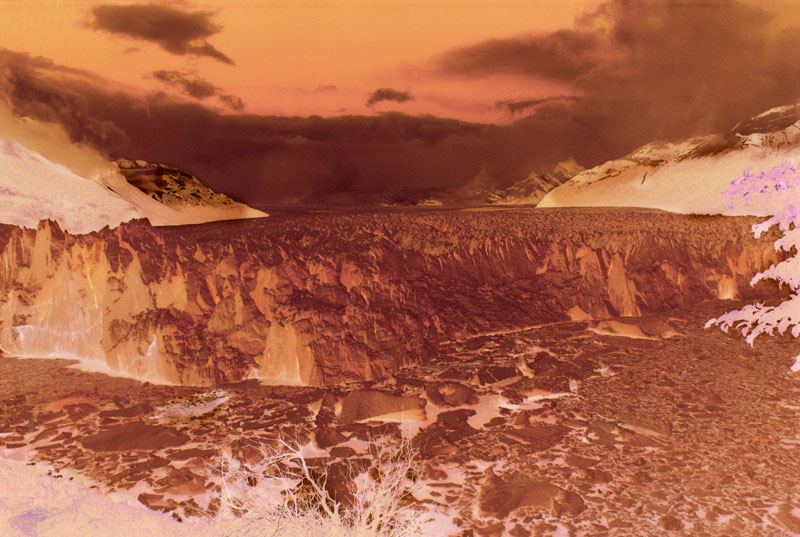Low Life
Block
March 6 – 15 2003
 |
| Philipa Veitch, Lower Beings, 67,000 BC, Production still, super 8 finished on VHS, colour, 8′, 2003 |
 |
| Philipa Veitch, Denature, LED print, 1020mm x 800mm, 2003 |
 |
| Philipa Veitch, Hidden in Leaves, LED print, 1020mm x 800mm, 2003 |
Low Life was one of the last exhibitions to take place at BLOCK in Erskine St Sydney, (previously home to CBD and W.I.N.D.O.W. galleries), thus ending one of the longest running homes of Artist Run Spaces in Sydney.
Low Life incorporated a combination of large scale coloured pencil drawing, slide projections, transfered super 8 footage and negative prints along the line of those used in Nature Strip (2000), and was informed by an interest in volcanic activity and the microbial lifeforms that make their home there. Many of the images used in this show came directly from documentation from a trip to the Hawai’ian volcanoes taken in 2002. An extract from my initial proposal goes into more detail…
Mauna Loa on the Big Island of Hawai’i is the tallest and most massive mountain on Earth. measured from it’s base on the sea floor, it rises to 56,000 feet, a result of 70 million years of volcanic eruptions and lava flows. Kilauea, also on Hawai’i, has been in almost continuous eruption since 1983. The Hawai’ian lavas rise from a primary magma chamber about 60 kilometres below sea level to a secondary magma chamber just below the volcanoes. A standard Hawai’ian eruption can produce 0.1 km cubed of lava and empty the secondary chamber. The Kilauea area is a vast landscape of primordial, misshapen, uncanny volcanic forms. Blackened, solidified lava flows, sometimes up to 10 metres high, stretch for kilometres having obliterated every living thing in its path. Fields of ash, pumice and cinder cover other areas, while the caldera or crater itself smoulders from its many steam vents and beds of sulphur. Down at the waters edge the volcano is in the process of land building, creating platforms of lava that soldify amidst enormous plumes of sulphurous smoke as it pours into the Pacific Ocean. The relatively unweathered fresh lava at the coast still retains it’s warmth and bizarre forms, and is coated in a thin glass-like membrane. In this state it seems to most truly evoke its molten subterranean origins.
Extreme environments such as those that exist in molten volcanic magma, in geothermal springs and hydrothermal vents in the faultlines on the ocean floor are now known to host life, extremophiles that thrive in super hot temperatures and high pressures. These bacteria live in precisely the type of volcanic environments that resemble Earth at the time the earliest fossil life has been found, the Archaen period 3-4 million years ago. During the Archaen period the Earth’s surface had cooled just enough to form a thin crust that lay uneasily on the thin mantle. Volcanoes erupted continously from the rifts and cracks, while meteorites cratered the Earth and threw up huge plumes of dust and smoke. Fossil microorganisms similar to the thermophiles found today have been dated to this Archaen period, making them likely candidates as the forerunners to all life on Earth.
Low Life explores some of the environments and theories of this early period in Earth’s development, and their ramifications for finding life outside of Earth.
Philipa Veitch, 2003

